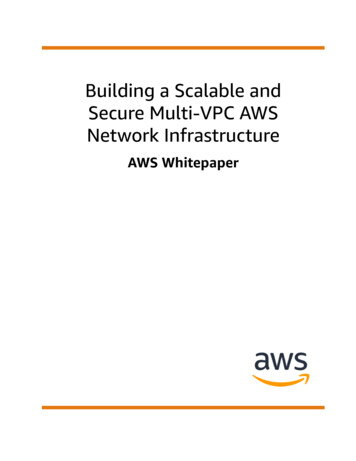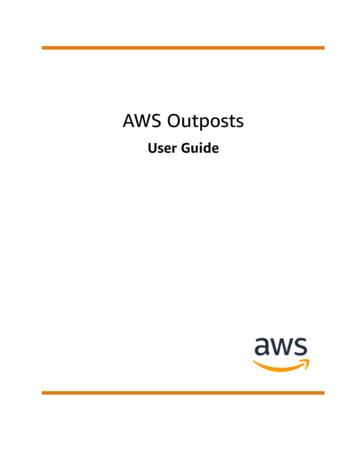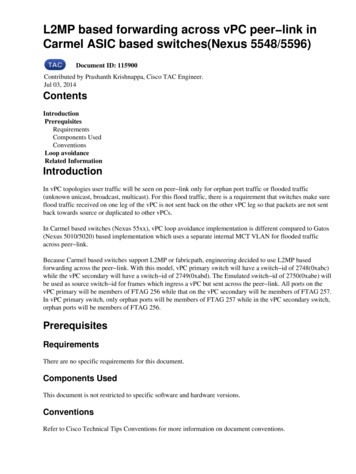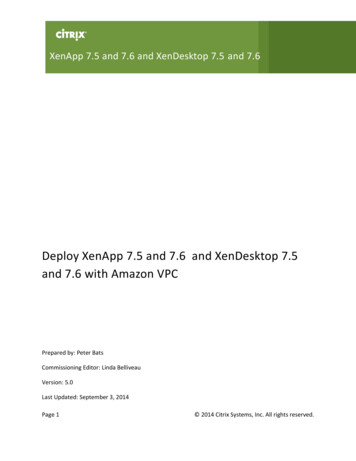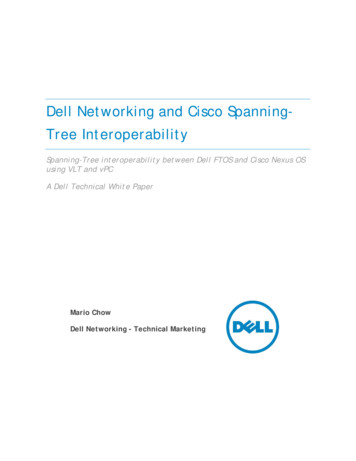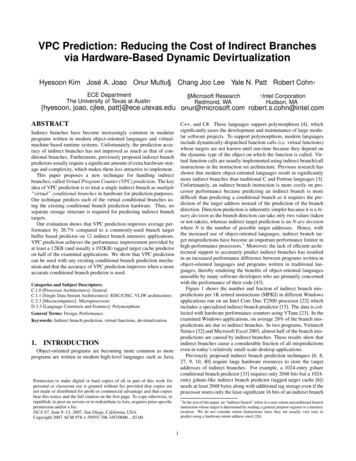
Transcription
VPC Prediction: Reducing the Cost of Indirect Branchesvia Hardware-Based Dynamic DevirtualizationHyesoon Kim José A. Joao Onur Mutlu§ Chang Joo Lee Yale N. Patt Robert Cohn†ECE DepartmentThe University of Texas at Austin§Microsoft ResearchRedmond, WA†Intel CorporationHudson, MA{hyesoon, joao, cjlee, patt}@ece.utexas.edu onur@microsoft.com robert.s.cohn@intel.comABSTRACTC , and C#. These languages support polymorphism [4], whichsignificantly eases the development and maintenance of large modular software projects. To support polymorphism, modern languagesinclude dynamically-dispatched function calls (i.e. virtual functions)whose targets are not known until run-time because they depend onthe dynamic type of the object on which the function is called. Virtual function calls are usually implemented using indirect branch/callinstructions in the instruction set architecture. Previous research hasshown that modern object-oriented languages result in significantlymore indirect branches than traditional C and Fortran languages [3].Unfortunately, an indirect branch instruction is more costly on processor performance because predicting an indirect branch is moredifficult than predicting a conditional branch as it requires the prediction of the target address instead of the prediction of the branchdirection. Direction prediction is inherently simpler because it is a binary decision as the branch direction can take only two values (takenor not-taken), whereas indirect target prediction is an N-ary decisionwhere N is the number of possible target addresses. Hence, withthe increased use of object-oriented languages, indirect branch target mispredictions have become an important performance limiter inhigh-performance processors. 1 Moreover, the lack of efficient architectural support to accurately predict indirect branches has resultedin an increased performance difference between programs written inobject-oriented languages and programs written in traditional languages, thereby rendering the benefits of object-oriented languagesunusable by many software developers who are primarily concernedwith the performance of their code [43].Figure 1 shows the number and fraction of indirect branch mispredictions per 1K retired instructions (MPKI) in different Windowsapplications run on an Intel Core Duo T2500 processor [22] whichincludes a specialized indirect branch predictor [15]. The data is collected with hardware performance counters using VTune [23]. In theexamined Windows applications, on average 28% of the branch mispredictions are due to indirect branches. In two programs, VirtutechSimics [32] and Microsoft Excel 2003, almost half of the branch mispredictions are caused by indirect branches. These results show thatindirect branches cause a considerable fraction of all mispredictionseven in today’s relatively small-scale desktop applications.Previously proposed indirect branch prediction techniques [6, 8,27, 9, 10, 40] require large hardware resources to store the targetaddresses of indirect branches. For example, a 1024-entry gshareconditional branch predictor [33] requires only 2048 bits but a 1024entry gshare-like indirect branch predictor (tagged target cache [6])needs at least 2048 bytes along with additional tag storage even if theprocessor stores only the least significant 16 bits of an indirect branchIndirect branches have become increasingly common in modularprograms written in modern object-oriented languages and virtualmachine based runtime systems. Unfortunately, the prediction accuracy of indirect branches has not improved as much as that of conditional branches. Furthermore, previously proposed indirect branchpredictors usually require a significant amount of extra hardware storage and complexity, which makes them less attractive to implement.This paper proposes a new technique for handling indirectbranches, called Virtual Program Counter (VPC) prediction. The keyidea of VPC prediction is to treat a single indirect branch as multiple“virtual” conditional branches in hardware for prediction purposes.Our technique predicts each of the virtual conditional branches using the existing conditional branch prediction hardware. Thus, noseparate storage structure is required for predicting indirect branchtargets.Our evaluation shows that VPC prediction improves average performance by 26.7% compared to a commonly-used branch targetbuffer based predictor on 12 indirect branch intensive applications.VPC prediction achieves the performance improvement provided byat least a 12KB (and usually a 192KB) tagged target cache predictoron half of the examined applications. We show that VPC predictioncan be used with any existing conditional branch prediction mechanism and that the accuracy of VPC prediction improves when a moreaccurate conditional branch predictor is used.Categories and Subject Descriptors:C.1.0 [Processor Architectures]: GeneralC.1.1 [Single Data Stream Architectures]: RISC/CISC, VLIW architecturesC.5.3 [Microcomputers]: MicroprocessorsD.3.3 [Language Constructs and Features]: PolymorphismGeneral Terms: Design, Performance.Keywords: Indirect branch prediction, virtual functions, devirtualization.1.INTRODUCTIONObject-oriented programs are becoming more common as moreprograms are written in modern high-level languages such as Java,Permission to make digital or hard copies of all or part of this work forpersonal or classroom use is granted without fee provided that copies arenot made or distributed for profit or commercial advantage and that copiesbear this notice and the full citation on the first page. To copy otherwise, torepublish, to post on servers or to redistribute to lists, requires prior specificpermission and/or a fee.ISCA’07, June 9–13, 2007, San Diego, California, USA.Copyright 2007 ACM 978-1-59593-706-3/07/0006 . 5.00.1In the rest of this paper, an “indirect branch” refers to a non-return unconditional branchinstruction whose target is determined by reading a general purpose register or a memorylocation. We do not consider return instructions since they are usually very easy topredict using a hardware return address stack [26].1
5550454035indirect branches3025201510cy lgwsq inlsew rvinex rpie lorexplo rrem eracfir sefoxvtunpp ena tvisa ew-worlou dwitde loo ndskto kpseav ar cid hac arorew adinamw pindvdAVGcesim0ics5exPercentage of all mispredicted branches (%)cy lgwsq inlsew rvinex rpie lorexplo rrem eracfir sefoxvtunpp ena tvisa ew-worlou dwide tloo ndskto kpseav ar cid hac arorew adinamw pindvdAVGicsceexMispredictions Per Kilo Instructions Figure 1: Indirect branch mispredictions in Windows applications: MPKI for conditional and indirect branches (left), percentage ofmispredictions due to indirect branches (right)target address in each entry. 2 As such a large hardware storage comeswith an expensive increase in power/energy consumption and complexity, most current high-performance processors do not dedicateseparate hardware but instead use the branch target buffer (BTB) topredict indirect branches [1, 18, 28], which implicitly –and usuallyinaccurately– assumes that the indirect branch will jump to the sametarget address it jumped to in its previous execution [6, 27].3 To ourknowledge, only Intel Pentium M implements specialized hardwareto help the prediction of indirect branches [15], demonstrating thathardware designers are increasingly concerned with the performanceimpact of indirect branches. However, as we showed in Figure 1,even on a processor based on the Pentium M, indirect branch mispredictions are still relatively frequent.In order to efficiently support polymorphism in object-orientedlanguages without significantly increasing complexity in the processor front-end, a simple and low-cost –yet effective– indirect branchpredictor is necessary. A current high-performance processor alreadyemploys a large and accurate conditional branch predictor. Our goalis to use this existing conditional branch prediction hardware to alsopredict indirect branches instead of building separate, costly indirectbranch prediction structures.We propose a new indirect branch prediction algorithm: VirtualProgram Counter (VPC) prediction. A VPC predictor treats a singleindirect branch as multiple conditional branches (virtual branches) inhardware for prediction purposes. Conceptually, each virtual branchhas its own unique target address, and the target address is stored inthe BTB with a unique “fake” PC, which we call virtual PC. The processor uses the outcome of the existing conditional branch predictorto predict each virtual branch. The processor accesses the conditionalbranch predictor and the BTB with the virtual PC address of a virtualbranch. If the prediction for the virtual branch is “taken,” the targetaddress provided by the BTB is predicted as the next fetch address(i.e. the predicted target of the indirect branch). If the prediction ofthe virtual branch is “not-taken,” the processor moves on to the nextvirtual branch: it tries a conditional branch prediction again with adifferent virtual PC. The processor repeats this process until the conditional branch predictor predicts a virtual branch as taken. VPC prediction stops if none of the virtual branches is predicted as taken aftera limited number of virtual branch predictions. After VPC predictionstops, the processor can stall the front-end until the target address ofthe indirect branch is resolved.The VPC prediction algorithm is inspired by a compiler optimization, called receiver class prediction optimization (RCPO) [7, 19,16, 2] or devirtualization [24]. This optimization statically convertsan indirect branch to multiple direct conditional branches (in otherwords, it “devirtualizes” a virtual function call). Unfortunately, devirtualization requires extensive static program analysis or accurateprofiling, and it is applicable to only a subset of indirect brancheswith a limited number of targets that can be determined statically [24].Our proposed VPC prediction mechanism provides the benefit of using conditional branch predictors for indirect branches without requiring static analysis or profiling by the compiler. In other words,VPC prediction dynamically devirtualizes an indirect branch withoutcompiler support. Unlike compiler-based devirtualization, VPC prediction can be applied to any indirect branch regardless of the numberand locations of its targets.The contributions of VPC prediction are as follows:1. To our knowledge, VPC prediction is the first mechanism thatuses the existing conditional branch prediction hardware topredict the targets of indirect branches, without requiring anyprogram transformation or compiler support.2. VPC prediction can be applied using any current as well as future conditional branch prediction algorithm without requiringchanges to the conditional branch prediction algorithm. SinceVPC prediction transforms the problem of indirect branchprediction into the prediction of multiple virtual conditionalbranches, future improvements in conditional branch prediction accuracy can implicitly result in improving the accuracyof indirect branch prediction.3. Unlike previously proposed indirect branch prediction schemes,VPC prediction does not require extra storage structures tomaintain the targets of indirect branches. Therefore, VPC prediction provides a low-cost indirect branch prediction schemethat does not significantly complicate the front-end of the processor while providing the same performance as more complicated indirect branch predictors that require significant amountsof storage.2With a 64-bit address space, a conventional indirect branch predictor likely requireseven more hardware resources to store the target addresses [27].3Previous research has shown that the prediction accuracy of a BTB-based indirectbranch predictor, which is essentially a last-target predictor, is low (about 50%) becausethe target addresses of many indirect branches alternate rather than stay stable for longperiods of time [6, 27].2
2.BACKGROUND ON INDIRECT BRANCHPREDICTION1: // Set up the array of function pointers (i.e. jump table)2: EvTab[T INT] Eval INT; EvTab[T VAR] Eval VAR;3: EvTab[T SUM] Eval SUM;4: // .5:6: // EVAL evaluates an expression by calling the function7: // corresponding to the type of the expression8: // using the EvTab[] array of function pointers9:10: #define EVAL(hd) ((*EvTab[TYPE(hd)])((hd))) /*INDIRECT*/11:12: TypHandle Eval LISTELEMENT ( TypHandle hdSel ) {13:hdPos EVAL( hdSel );14:// evaluate the index of the list element15:// check if index is valid and within bounds16:// if within bounds, access the list17:// at the given index and return the element18: }We first provide a brief background on how indirect branch predictors work to motivate the similarity between indirect and conditionalbranch prediction. There are two types of indirect branch predictors: history-based and precomputation-based [37]. The techniquewe introduce in this paper utilizes history information, so we focuson history-based indirect branch predictors.2.1 Why Does History-Based Indirect BranchPrediction Work?History-based indirect branch predictors exploit information aboutthe control-flow followed by the executing program to differentiatebetween the targets of an indirect branch. The insight is that thecontrol-flow path leading to an indirect branch is strongly correlatedwith the target of the indirect branch [6]. This is very similar to modern conditional branch predictors, which operate on the observationthat the control-flow path leading to a branch is correlated with thedirection of the branch [11].2.1.1Figure 2: An indirect branch example from GAPChang et al. [6] first proposed to use branch history information todistinguish between different target addresses accessed by the sameindirect branch. They proposed the “target cache,” which is similarto a two-level gshare [33] conditional branch predictor. The targetcache is indexed using the XOR of the indirect branch PC and thebranch history register. Each cache entry contains a target address.Each entry can be tagged, which reduces interference between different indirect branches. The tagged target cache significantly improvesindirect branch prediction accuracy compared to a BTB-based predictor. However, it also requires separate structures for predictingindirect branches, increasing complexity in the processor front-end.Later work on indirect branch prediction by Driesen and Hölzlefocused on improving the prediction accuracy by enhancing the indexing functions of two-level predictors [8] and by combining multiple indirect branch predictors using a cascaded predictor [9, 10].The cascaded predictor is a hybrid of two or more target predictors.A relatively simple first-stage predictor is used to predict easy-topredict (single-target) indirect branches, whereas a complex secondstage predictor is used to predict hard-to-predict indirect branches.Driesen and Hölzle [10] concluded that a 3-stage cascaded predictorperformed the best for a particular set of C and C benchmarks.Kalamatianos and Kaeli [27] proposed predicting indirectbranches via data compression. Their predictor uses prediction bypartial matching (PPM) with a set of Markov predictors of decreasing size indexed by the result of hashing a decreasing number of bitsfrom previous targets. The Markov predictor is a large set of tableswhere each table entry contains a single target address and bookkeeping bits. The prediction comes from the highest order table thatcan predict, similarly to a cascaded predictor. The PPM predictorrequires significant additional hardware complexity in the indexingfunctions, Markov tables, and additional muxes used to select thepredicted target address.Recently, Seznec and Michaud [40] proposed extending theirTAGE conditional branch predictor to also predict indirect branches.However, their mechanism also requires additional storage space forindirect target addresses and additional complexity to handle indirectbranches.A Source Code ExampleThe example in Figure 2 shows an indirect branch from the GAPprogram [12] to provide insight into why history-based predictionof indirect branch targets works. GAP implements and interpretsa language that performs mathematical operations. One data structure in the GAP language is a list. When a mathematical functionis applied to a list element, the program first evaluates the value ofthe index of the element in the list (line 13 in Figure 2). The index can be expressed in many different data types, and a differentfunction is called to evaluate the index value based on the data type(line 10). For example, in expressions L(1), L(n), and L(n 1), theindex is of three different data types: T INT, T VAR, and T SUM,respectively. An indirect jump through a jump table (EvTab in lines2, 3 and 10) determines which evaluation function is called basedon the data type of the index. Consider the mathematical functionL2(n) L1(n) L1(n 1). For each n, the program calculates threeindex values; Eval VAR, Eval SUM, and Eval VAR functions arecalled respectively to evaluate index values for L1(n), L1(n 1), andL2(n). The targets of the indirect branch that determines the evaluation function of the index are therefore respectively the addresses ofthe two evaluation functions. Hence, the target of this indirect branchalternates between the two functions, making it unpredictable with aBTB-based last-target predictor. In contrast, a predictor that usesbranch history information to predict the target easily distinguishesbetween the two target addresses because the branch histories followed in the functions Eval SUM and Eval VAR are different; hencethe histories leading into the next instance of the indirect branch usedto evaluate the index of the element are different. Note that a combination of the regularity in the input index expressions and the codestructure allows the target address to be predictable using branch history information.2.2 Previous WorkThe indirect branch predictor described by Lee and Smith [30]used the branch target buffer (BTB) to predict indirect branches. Thisscheme predicts that the target of the current instance of the branchwill be the same as the target taken in the last execution of the branch.This scheme does not work well for indirect branches that frequentlyswitch between different target addresses. Such indirect branches arecommonly used to implement virtual function calls that act on manydifferent objects and switch statements with many ‘case’ targets thatare exercised at run-time. Therefore, the BTB-based predictor haslow (about 50%) prediction accuracy [30, 6, 8, 27].2.3Our MotivationAll previously proposed indirect branch predictors (except theBTB-based predictor) require separate hardware structures to storetarget addresses in addition to the conditional branch prediction hardware. This not only requires significant die area (which translatesinto extra energy/power consumption), but also increases the designcomplexity of the processor front-end, which is already a complex3
and cycle-critical part of the design.4 Moreover, many of the previously proposed indirect branch predictors are themselves complicated [9, 10, 27, 40], which further increases the overall complexityand development time of the design. For these reasons, most currentprocessors do not implement separate structures to predict indirectbranch targets.Our goal in this paper is to design a low-cost technique that accurately predicts indirect branch targets (by utilizing branch historyinformation to distinguish between the different target addresses ofa branch) without requiring separate complex structures for indirectbranch prediction. To this end, we propose Virtual Program Counter(VPC) prediction.3.branch is fetched. If the virtual branch is predicted not-taken, theprediction algorithm moves to the next iteration (i.e. the next virtualbranch) by updating the VPCA and VGHR. The VPCA value for aniteration (other than the first iteration) is computed by hashing theoriginal PC value with a randomized constant value that is specific tothe iteration. In other words, V P CA P C HASHV AL[iter],where HASHVAL is a hard-coded hardware table of randomizednumbers that are different from one another. The VGHR is simplyleft-shifted by one bit at the end of each iteration to indicate that thelast virtual branch was predicted not taken.6The iterative prediction process stops when a virtual branch is predicted to be taken. Otherwise, the prediction process iterates untileither the number of iterations is greater than MAX ITER or thereis a BTB miss (!pred target in Algorithm 1 means there is a BTBmiss).7 If the prediction process stops without predicting a target, theprocessor stalls until the indirect branch is resolved.Note that the value of MAX ITER determines how many attemptswill be made to predict an indirect branch. It also dictates how manydifferent target addresses can be stored for an indirect branch at agiven time in the BTB.VIRTUAL PROGRAM COUNTER (VPC)PREDICTION3.1 OverviewA VPC predictor treats an indirect branch as a sequence of multiple virtual conditional branches.5 Each virtual branch is predicted insequence using the existing conditional branch prediction hardware,which consists of the direction predictor and the BTB (Figure 3).If the virtual branch is predicted to be not-taken, the VPC predictormoves on to predict the next virtual branch in the sequence. If the virtual branch is predicted to be taken, VPC prediction uses the targetassociated with the virtual branch in the BTB as the next fetch address, completing the prediction of the indirect branch. Note that thevirtual branches are visible only to the branch prediction rithm 1 VPC prediction algorithmiter 1V P CA P CV GHR GHRdone F ALSEwhile (!done) dopred target access BTB(V P CA)pred dir access conditional BP(V P CA, V GHR)if (pred target and (pred dir T AKEN )) thennext P C pred targetdone T RU Eelse if (!pred target or (iter M AX IT ER)) thenST ALL T RU Edone T RU Eend ifV P CA Hash(P C, iter)V GHR Left-Shift(V GHR)iter end whileTaken/Not TakenPredict?PCVPCABTBCond/IndirectTarget AddressHash FunctionIterationCounter3.2.1Figure 3: High-level conceptual overview of the VPC predictorPrediction ExampleFigure 4a,b shows an example virtual function call and the corresponding simplified assembly code with an indirect branch. Figure 4cshows the virtual conditional branches corresponding to the indirectbranch. Even though the static assembly code has only one indirect branch, the VPC predictor treats the indirect branch as multipleconditional branches that have different targets and VPCAs. Notethat the hardware does not actually generate multiple conditionalbranches. The instructions in Figure 4c are shown to demonstrateVPC prediction conceptually. We assume, for this example, thatMAX ITER is 3, so there are only 3 virtual conditional branches.Table 1 demonstrates the five possible cases when the indirectbranch in Figure 4 is predicted using VPC prediction, by showingthe inputs and outputs of the VPC predictor in each iteration. We3.2 Prediction AlgorithmThe detailed VPC prediction algorithm is shown in Algorithm 1.The key implementation issue in VPC prediction is how to distinguishbetween different virtual branches. Each virtual branch should access a different location in the direction predictor and the BTB (sothat a separate direction and target prediction can be made for eachbranch). To accomplish this, the VPC predictor accesses the conditional branch prediction structures with a different virtual PC address(VPCA) and a virtual global history register (GHR) value (VGHR)for each virtual branch. VPCA values are distinct for different virtualbranches. VGHR values provide the context (branch history) information associated with each virtual branch.VPC prediction is an iterative prediction process, where each iteration takes one cycle. In the first iteration (i.e. for the first virtualbranch), VPCA is the same as the original PC address of the indirectbranch and VGHR is the same as the GHR value when the indirect6Note that VPC addresses (VPCAs) can conflict with real PC addresses in the program,thereby increasing aliasing and contention in the BTB and the direction prediction structures. The processor does not require any special action when aliasing happens. Toreduce such aliasing, the processor designer should: (1) provide a good randomizinghashing function and values to generate VPCAs and (2) co-design the VPC predictionscheme and the conditional branch prediction structures carefully to minimize the effectsof aliasing. Conventional techniques proposed to reduce aliasing in conditional branchpredictors [33, 5] can also be used to reduce aliasing due to VPC.7The VPC predictor can continue iterating the prediction process even if there is BTBmiss. However, we found that continuing in this case does not improve the predictionaccuracy. Hence, to simplify the prediction process, our VPC predictor design stops theprediction process when there is a BTB miss in any iteration.4Using a separate predictor for indirect branch targets adds one more input to the muxthat determines the predicted next fetch address. Increasing the delay of this mux canresult in increased cycle time, adversely affecting the clock frequency.5We call the conditional branches “virtual” because they are not encoded in the programbinary. Nor are they micro-operations since they are only visible to the VPC predictor.4
Table 1: Possible VPC Predictor states and outcomes when branch in Figure 4b is predictedCase123451st 1TARG1NTL1111TARG1NTL1111TARG1NTL1111TARG1NT2nd 21110TARG2NTVL21110TARG2NTVL21110MISS-a s- area ();(a) Source codeR1 MEM[R2]INDIRECT CALL R1 // PC: L(b) Corresponding assembly code with an indirect branch3rd 100TARG3NT-PredictionTARG1TARG2TARG3stallstall(c) Virtual conditional branches (for prediction purposes)target) train the direction predictor as not-taken (as shown in Algorithm 2). The last virtual branch trains the conditional branch predictor as taken and updates the replacement policy bits in the BTB entrycorresponding to the correctly-predicted target address. Note thatAlgorithm 2 is a special case of Algorithm 3 in that it is optimizedto eliminate unnecessary BTB accesses when the target prediction iscorrect.Figure 4: VPC prediction example: source, assembly, and thecorresponding virtual branchesAlgorithm 2 VPC training algorithm when the branch target is correctly predicted. Inputs: predicted iter, P C, GHRiter1: cond. br TARG1 // VPCA: Liter2: cond. br TARG2 // VPCA: VL2 L XOR HASHVAL[1]iter3: cond. br TARG3 // VPCA: VL3 L XOR HASHVAL[2]iter 1V P CA P CV GHR GHRwhile (iter predicted iter) doif (iter predicted iter) thenupdate conditional BP(V P CA, V GHR, TAKEN)update replacement BTB(V P CA)elseupdate conditional BP(V P CA, V GHR, NOT-TAKEN)end ifV P CA Hash(PC, iter)V GHR Left-Shift(V GHR)iter end whileassume that the GHR is 1111 when the indirect branch is fetched.Cases 1, 2, and 3 correspond to cases where respectively the first,second, or third virtual branch is predicted taken by the conditionalbranch direction predictor (BP). As VPC prediction iterates, VPCAand VGHR values are updated as shown in the table. Case 4 corresponds to the case where all three of the virtual branches are predictednot-taken and therefore the outcome of the VPC predictor is a stall.Case 5 corresponds to a BTB miss for the second virtual branch andthus also results in a stall.3.3 Training AlgorithmThe VPC predictor is trained when an indirect branch is committed. The detailed VPC training algorithm is shown in Algorithms 2 and 3. Algorithm 2 is used when the VPC prediction wascorrect and Algorithm 3 is used when the VPC prediction was incorrect. The VPC predictor trains both the BTB and the conditionalbranch direction predictor for each predicted virtual branch. The keyfunctions of the training algorithm are:Algorithm 3 VPC training algorithm when the branch target is mispredicted. Inputs: P C, GHR, CORRECT T ARGETiter 1V P CA P CV GHR GHRf ound correct target F ALSEwhile ((iter M AX IT ER) and (f ound correct target F ALSE)) dopred target access BTB(V P CA)if (pred target CORRECT TARGET) thenupdate conditional BP(V P CA, V GHR, TAKEN)update replacement BTB(V P CA)f ound correct target T RU Eelse if (pred target) thenupdate conditional BP(V P CA, V GHR, NOT-TAKEN)end ifV P CA Hash(PC, iter)V GHR Left-Shift(V GHR)iter end while1. to update the direction predictor as not-taken for the virtualbranches that have the wrong target (because the targets ofthose branches were not taken) and to update it as taken forthe virtual branch, if any, that has the correct target.2. to update the replacement policy bits of the correct target in theBTB (if the correct target exists in the BTB)3. to insert the correct target address into the BTB (if the correcttarget does not exist in the BTB)Like prediction, training is also an iterative process. To facilitatetraining on a correct prediction, an indirect branch carries with itthrough the pipeline the number of iterations performed to predict thebranch (predicted iter). VPCA and VGHR values for each training iteration are recalculated exactly the same way as in the prediction algorithm. Note that only one virtual branch trains the predictionstructures in a given cycle.83.3.1/* no-target case */if (f ound correct target F ALSE) thenV P CA VPCA corresponding to the virtual branch with a BTB-Miss orLeast-frequently-used target among all virtual branchesV GHR VGHR corresponding to the virtual branch with a BTB-Miss orLeast
the BTB with a unique "fake" PC, which we call virtual PC. The pro-cessor uses the outcome of the existing conditional branch predictor to predict each virtual branch. The processor accesses the conditional branch predictor and the BTB with the virtual PC address of a virtual branch. If the prediction for the virtual branch is "taken .
